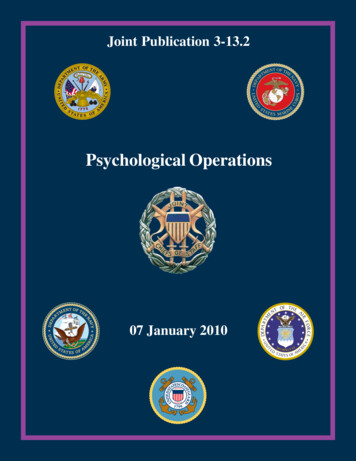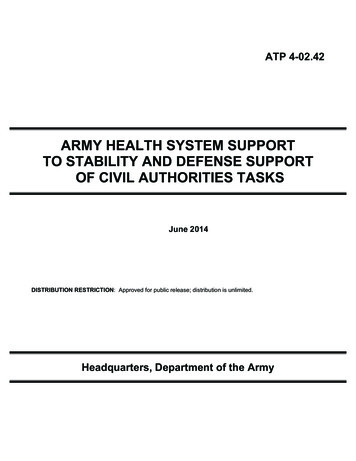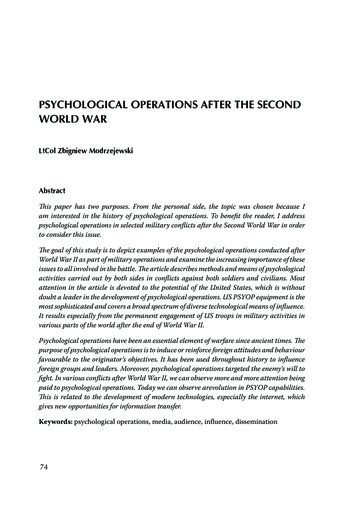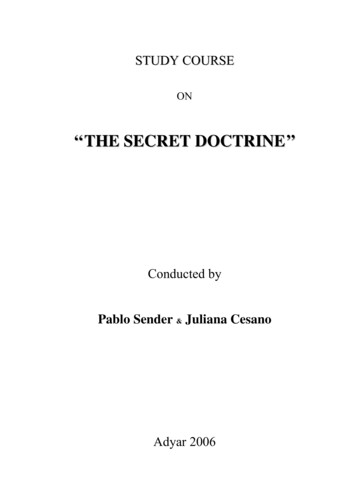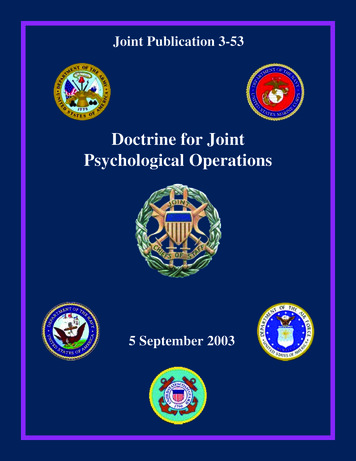
Transcription
Joint Publication 3-53Doctrine for JointPsychological Operations5 September 2003
PREFACE1.ScopeThis publication addresses military psychological operations planning and execution insupport of joint, multinational, and interagency efforts across the range of military operations.2.PurposeThis publication has been prepared under the direction of the Chairman of the Joint Chiefsof Staff. It sets forth doctrine to govern the joint activities and performance of the Armed Forcesof the United States in joint operations and provides the doctrinal basis for US military involvementin multinational and interagency operations. It provides military guidance for the exercise ofauthority by combatant commanders and other joint force commanders (JFCs) and prescribesdoctrine for joint operations and training. It provides military guidance for use by the ArmedForces in preparing their appropriate plans. It is not the intent of this publication to restrict theauthority of the JFC from organizing the force and executing the mission in a manner the JFCdeems most appropriate to ensure unity of effort in the accomplishment of the overall mission.3.Applicationa. Doctrine and guidance established in this publication apply to the commanders ofcombatant commands, subunified commands, joint task forces, and subordinate components ofthese commands. These principles and guidance also may apply when significant forces of oneService are attached to forces of another Service or when significant forces of one Servicesupport forces of another Service.b. The guidance in this publication is authoritative; as such, this doctrine will be followedexcept when, in the judgment of the commander, exceptional circumstances dictate otherwise.If conflicts arise between the contents of this publication and the contents of Service publications,this publication will take precedence for the activities of joint forces unless the Chairman of theJoint Chiefs of Staff, normally in coordination with the other members of the Joint Chiefs ofStaff, has provided more current and specific guidance. Commanders of forces operating as partof a multinational (alliance or coalition) military command should follow multinational doctrineand procedures ratified by the United States. For doctrine and procedures not ratified by theUnited States, commanders should evaluate and follow the multinational command’s doctrineand procedures, where applicable and consistent with US law, regulations, and doctrine.For the Chairman of the Joint Chiefs of Staff:JAMES A. HAWKINSMajor General, USAFVice Director, Joint Staffi
PrefaceIntentionally BlankiiJP 3-53
SUMMARY OF CHANGESREVISION OF JOINT PUBLICATION 3-53 DATED 10 JULY 1996 Revises the categories of military psychological operations to strategic,operational, and tactical Discusses missions supported by psychological operations Covers the concept of psychological operations measures of effectiveness Explains in detail the integration of psychological operations withinformation operations Updates the duties and responsibilities of the organizations involved withpsychological operations Clarifies the command relationships over psychological operations forces Discusses psychological operations planning in support of the jointcampaign Provides guidance on the psychological operations approval process, toinclude approval of psychological operations objectives and themes andpsychological operations products Expands the discussion of peacetime psychological operations to includetheater security cooperation plans Discusses psychological operations support to joint force campaign phasing Includes a discussion of psychological operations during interagencyoperations and multinational operations Provides a sample of the psychological operations tab to the informationoperations appendix of an operation plan or orderiii
Summary of ChangesIntentionally BlankivJP 3-53
TABLE OF CONTENTSPAGEEXECUTIVE SUMMARY . ixCHAPTER IPSYCHOLOGICAL OPERATIONS: AN OVERVIEW General . I-1Statutes and Policy . I-2Treaties and Agreements . I-2Military Psychological Operations . I-2Policies and Strategies . I-3Missions . I-5Principles of Joint Psychological Operations . I-5Psychological Operations Relationships . I-9Psychological Operations Integration with Information Operations . I-11CHAPTER IIORGANIZATIONAL RESPONSIBILITIES FOR PSYCHOLOGICAL OPERATIONS Responsibilities. II-1United States Forces Commanders Serving in Multinational Commands . II-7Other United States Government Agencies . II-8CHAPTER IIICOMMAND RELATIONSHIPS General . III-1Organizing Psychological Operations Forces . III-2CHAPTER IVPSYCHOLOGICAL OPERATIONS PLANNING IN SUPPORT OF THEJOINT FORCE CAMPAIGN Objectives of Joint Psychological Operations . IV-1Planning Skills . IV-1Psychological Operations Concepts. IV-3Psychological Operations Functions . IV-4Planning Guidance . IV-7Psychological Operations Support to Joint Force Campaign Phasing . IV-8Psychological Operations Plan Development . IV-13Psychological Operations Studies Program . IV-14Coordination with other Government Agencies . IV-16v
Table of ContentsCHAPTER VPSYCHOLOGICAL OPERATIONS APPROVAL PROCESS Operation Plan Approval .Psychological Operations Product Approval .Approval Process in Multinational Operations .Peacetime Psychological Operations Approval .Summary .V-1V-1V-3V-3V-4CHAPTER VIPSYCHOLOGICAL OPERATIONS ACROSS THE RANGE OF MILITARYOPERATIONS General . VI-1Theater Security Cooperation and Peacetime Psychological Operations . VI-4Psychological Operations Support to the Targeting Process . VI-6Psychological Operations Support to Special Operations andInteragency Operations . VI-8Multinational Operations . VI-13CHAPTER VIIPSYCHOLOGICAL OPERATIONS ENABLERS Intelligence . VII-1Command, Control, Communications, and Computer Systems . VII-3Logistics . VII-4APPENDIXA Department of Defense Psychological Operations Capabilities .B Format for Tab D, (Psychological Operations) to Appendix 3,(Information Operations) to Annex C, (Operations) .C References.D Administrative Instructions .A-1B-1C-1D-1GLOSSARYPart I Abbreviations and Acronyms . GL-1Part II Terms and Definitions . GL-4FIGUREI-1I-2viCategories of Military Psychological Operations . I-4Psychological Operations Support Requirements . I-8JP 3-53
Table of ContentsIII-1III-2IV-1IV-2Combatant Commander Responsibilities. III-1Joint Force Organizational Options . III-4Joint Psychological Operations General Objectives . IV-2Examples of United States Psychological Operations Leaflets Producedand Disseminated in Afghanistan in Support of OperationENDURING FREEDOM . IV-5IV-3 Specific Psychological Operations Guidance and PlanningConsiderations . IV-8IV-4 Phases — Joint Campaign . IV-9V-1Psychological Operations Plan and Program Approval Authorities . V-2V-2Psychological Operations Program Approval Process . V-4V-3Psychological Operations Program and Product Approval . V-5VI-1 Joint Military Psychological Operations Objectives Across theRange of Military Operations . VI-2VI-2 Special Operations Supported by Psychological Operations . VI-8VII-1 The Intelligence Process . VII-2vii
Table of ContentsIntentionally BlankviiiJP 3-53
EXECUTIVE SUMMARYCOMMANDER’S OVERVIEW Provides an Overview of Psychological Operations Discusses Organizational Responsibilities for Psychological Operations Explains Command Relationships Discusses Psychological Operations Planning in Support of the Joint ForceCampaign Highlights the Psychological Operations Approval Process Discusses Psychological Operations Across the Range of MilitaryOperationsOverviewThe purpose ofpsychological operations(PSYOP) is to induce orreinforce foreign attitudesand behavior favorable tothe originator’s objectives.Psychological operations (PSYOP) are planned operations toconvey selected information and indicators to foreign audiencesto influence the emotions, motives, objective reasoning, andultimately the behavior of foreign governments, organizations,groups, and individuals. PSYOP are a vital part of the broadrange of US diplomatic, informational, military, and economicactivities. PSYOP characteristically are delivered as informationfor effect, used during peacetime and conflict, to inform andinfluence. When properly employed, PSYOP can save lives offriendly and/or adversary forces by reducing adversaries’ will tofight. By lowering adversary morale and reducing their efficiency,PSYOP can also discourage aggressive actions and createdissidence and disaffection within their ranks, ultimately inducingsurrender.There are three categoriesof military PSYOP:strategic, operational, andtactical.PSYOP are an integral part of military operations and, as such,are an inherent responsibility of all military commanders. Thereare three categories of military PSYOP, strategic, operational,and tactical, which are used to establish and reinforce foreignperceptions of US military, political, and economic power andresolve. Strategic PSYOP are international information activitiesconducted by US Government (USG) agencies to influenceforeign attitudes, perceptions, and behavior in favor of US goalsand objectives during peacetime and in times of conflict. Theseprograms are conducted predominantly outside the military arenabut can utilize Department of Defense (DOD) assets. Operationalix
Executive SummaryPSYOP are conducted across the range of military operations,including during peacetime, in a defined operational area topromote the effectiveness of the joint force commander’s (JFC’s)campaigns and strategies. Tactical PSYOP are conducted in thearea assigned a tactical commander across the range of militaryoperations to support the tactical mission against opposing forces.The President andSecretary of Defense issuenational security policythrough directives andstatements.During peacetime, the Secretary of Defense (or designatedrepresentative) translates national security policy into militarypolicy. Because the execution of policy routinely contains aninformational element and desires behavior favorable to itsintent, there is an inherent psychological dimension. Duringwar, policy flows directly from the President, as the Commanderin Chief of the Armed Forces of the United States, and theSecretary of Defense through the Chairman of the Joint Chiefs ofStaff to the combatant commanders. The combatant commanderis responsible for the centralized direction and conduct of PSYOPwithin the command’s area of responsibility.PSYOP supports jointforce commandermissions.PSYOP units support the JFC and contribute to all aspects of jointoperations by performing the following missions:Advising the supported commander through the targetingprocess regarding targeting restrictions, psychologicalactions, and psychological enabling actions to be executedby the military force.Influencing foreign populations by expressinginformation through selected conduits to influenceattitudes and behavior and to obtain compliance or noninterference with friendly military operations.Providing public information to foreign populations tosupport humanitarian activities, ease suffering, and restoreor maintain civil order.Serving as the supported commander’s voice to foreignpopulations by conveying the JFC’s intent.Countering adversary propaganda, misinformation,disinformation, and opposing information to correctlyportray friendly intent and actions, while denying othersthe ability to polarize public opinion and affect the politicalwill of the United States and its multinational partnerswithin an operational area.xJP 3-53
Executive SummaryOrganizational Responsibilities for Psychological OperationsOrganizationalresponsibilities for PSYOPinvolve many parts of theDepartment of Defense.The Secretary of Defense participates in the establishment ofnational security policy and objectives and provides strategicPSYOP advice to USG agencies and allies.The Under Secretary of Defense for Policy (USD [P]) approvesall PSYOP programs unless the authority is delegated to theAssistant Secretary of Defense (Special Operations/Low IntensityConflict) (ASD[SO/LIC]), and delegates product approval anddissemination authority to the appropriate level for peace,contingency, or war.The ASD(SO/LIC) acts as principal staff assistant and advisorto the Secretary of Defense, the Deputy Secretary of Defense,and the USD (P) on PSYOP matters; coordinates PSYOP policy,plans, and programs with other USG departments and agencies;develops PSYOP policy for the Department of Defense; reviewsand approves all PSYOP plans and programs delegated by theUSD(P); and evaluates the effectiveness of DOD PSYOP plansand programs.The Chairman of the Joint Chiefs of Staff advises the President,Secretary of Defense, and National Security Council on all mattersregarding PSYOP forces, capabilities, programs, and missions.Command RelationshipsUnless otherwise directedby the Secretary ofDefense, the Commander,US Special OperationsCommand exercisescombatant command(command authority) overall assigned militaryPSYOP forces.When directed by the Secretary of Defense, the Commander,US Special Operations Command transfers PSYOP forcesby attachment to geographic combatant commanders. Whenthese forces are transferred, the command relationship of thegaining commander (and the losing commander will relinquish)over those forces must be specified; in most cases that will beoperational control.PSYOP forces, organized as a joint psychological operations taskforce (JPOTF), normally serve as a subordinate joint commandof a joint force. The JPOTF exercises command and controlof those PSYOP assets assigned, attached, or in support fromthe Services components and, when applicable, from othernations. Further, although tactical PSYOP units are usuallyassigned to maneuver commanders, the JPOTF normally hascoordinating authority with tactical forces for developing,producing, and disseminating PSYOP products.xi
Executive SummaryThe scale of operationsgenerally will dictate theorganization of PSYOPforces.As a crisis begins to develop, one of the first elements deployed to asupported commander is the PSYOP assessment team (POAT).The POAT provides staff support to the operations directorate (J-3)of the joint force. The POAT assesses the situation, confers with thecommander, develops the PSYOP objectives, and recommends anappropriate combination of personnel, equipment, and supportprovided by Service components to accomplish the mission. If thePOAT assesses that significant PSYOP forces are required to supportthe JFC’s objectives, the POAT recommends to the JFC that a JPOTFor PSYOP support element be established.Psychological Operations Planning in Support of the Joint CampaignEffective use of PSYOPincreases the potential foroperational success.PSYOP are involved in all three types of planning processes forjoint operations: campaign, deliberate, and crisis action.Experience has repeatedly demonstrated that PSYOP plannersmust be involved throughout the planning process and thatbringing PSYOP in early to the process can significantly improvethe PSYOP contribution to the overall operation.The overall function of PSYOP is to cause selected foreignaudiences to take actions favorable to the objectives of the UnitedStates and its allies or coalition partners. PSYOP forces are theonly DOD asset given the authority to influence foreign targetaudiences (TAs) directly through the use of radio, print, and othermedia. PSYOP personnel specifically advise the supportedcommander on methods to capitalize on the psychological impactsof every aspect of force employment to achieve the overallcampaign objectives. Their duties are wide-ranging but include,as a minimum, advising on the psychological impacts of plannedoperations, the identification of foreign TAs, and anypsychological weaknesses.The Chairman of theJoint Chiefs of Staff’sexecute order (authorizedby the Secretary ofDefense) should designatewho has authority forPSYOP product approvaland PSYOP productdissemination.The Secretary of Defense normally delegates PSYOP productapproval to the supported combatant commander. This does notmean that the supported combatant commander also has beendelegated approval for PSYOP product dissemination. In somecases, PSYOP products may be politically sensitive and mayrequire separate approval for dissemination. The supportedcombatant commander may, in turn, delegate PSYOP productapproval to a joint task force (JTF) commander but not lowerwithout approval of the Secretary of Defense.In all PSYOP activities, commanders must be aware of two levels ofproduct approval. PSYOP objectives and themes frame the productsxiiJP 3-53
Executive Summarythat reach foreign TAs and reflect national and theater policy andstrategy. Approval of themes and messages is reserved by USG policyat Office of the Secretary of Defense-levels where the interagencyprocess can address PSYOP products with a broad range ofconsiderations. Commanders subordinate to JTF commanders canmodify approved products, within the guidelines issued by higherheadquarters, to better target local foreign TAs.Psychological Operations Across the Range of Military OperationsPSYOP support joint andmultinational operationsand designatedgovernment agencies.Military operations other than war (MOOTW) not involvingthe use or threat of force that can be supported by joint PSYOPinclude foreign humanitarian assistance, nation assistance, foreigninternal defense, consequence management, and DOD supportto counterdrug operations. These military activities providetraining and in-theater access to allow for the facilitation and useof PSYOP during the transition to war. Nonlethal activities suchas PSYOP can be decisive in MOOTW involving the use or threatof force. Joint PSYOP are capable of supporting operationsconducted during MOOTW, to include strikes and raids,combatting terrorism, foreign internal defense, enforcement ofsanctions and maritime intercept operations, peace operations(e.g., peace enforcement operations), noncombatant evacuationoperations or flexible deterrent options as directed. During warprehostilities, PSYOP can provide powerful operational leveragein support of flexible deterrent options. Among their potentialcontributions, PSYOP can be employed to gather criticalinformation, undermine a potential opponent’s will or capacityto wage war, or enhance the capabilities of multinational forces.During war, PSYOP at the strategic, operational, and tactical levelmay enhance the success of operations at all echelons.CONCLUSIONPSYOP are operations planned to convey selected information andindicators to influence the emotions, motives, objective reasoning, andultimately the behavior of foreign governments, organizations, groups,and individuals. To accomplish this goal, PSYOP must have a clearlydefined mission, the ability to analyze and evaluate targets and theireffects, a reliable media transmission, and a rapid ability to implementtheir activities. PSYOP depend on communications to ensure properexecution of the mission and objectives. This is accomplished bycommand and control, preplanning, and support from all levels of thechain of command.xiii
Executive SummaryIntentionally BlankxivJP 3-53
CHAPTER IPSYCHOLOGICAL OPERATIONS: AN OVERVIEW“In this war, which was total in every sense of the word, we have seen many greatchanges in military science. It seems to me that not the least of these was thedevelopment of psychological warfare as a specific and effective weapon.”General of the Army Dwight D. Eisenhower1.Generala. The employment of any instrument of national power, particularly the military instrument,has always had a psychological dimension. Foreign perceptions of US military capabilities arefundamental to strategic deterrence. The effectiveness of deterrence hinges on US ability toinfluence the perceptions of others. Psychological operations (PSYOP) are planned operationsto convey selected information and indicators to foreign audiences to influence their emotions,motives, objective reasoning, and ultimately the behavior of foreign governments, organizations,groups, and individuals. The purpose of PSYOP are to induce or reinforce foreign attitudes andbehavior favorable to the originator’s objectives. PSYOP are a vital part of the broad range ofUS diplomatic, informational, military, and economic activities. PSYOP characteristicallyare delivered as information for effect, used during peacetime and conflict, to inform andinfluence. When properly employed, PSYOP can save lives of friendly and/or adversary forcesby reducing adversaries’ will to fight. By lowering adversary morale and reducing their efficiency,PSYOP can also discourage aggressive actions and create dissidence and disaffection withintheir ranks, ultimately inducing surrender.b. The President and Secretary of Defense issue national security policy through directivesand statements. During peacetime, the Secretary of Defense (or designated representative)translates national security policy into military policy. Because the execution of policy routinelycontains an informational element and desires behavior favorable to its intent, there is an inherentpsychological dimension. During war, policy flows directly from the President, as the Commanderin Chief of the Armed Forces of the United States, and the Secretary of Defense through theChairman of the Joint Chiefs of Staff (CJCS) to the combatant commanders. The combatantcommander is responsible for the centralized direction and conduct of PSYOP within thecommand’s area of responsibility (AOR). Early and full PSYOP support to the supportedcommander is critical throughout the crisis action planning process.“[Members of the Joint Psychological Operations Task Force (JPOTF) of the JointTask Force (JTF) NOBLE ANVIL] . . . Psychological Operations (PSYOP) playeda key role throughout Operation ALLIED FORCE. Your efforts at influencingdiverse groups ranging from Serb military and police forces in Kosovo, to thecivilian population in Belgrade and in small towns and villages throughout theremainder of Serbia, to Kosovar Albanian refugees in camps in Albania andMacedonia, were truly impressive. Although difficult to measure, I truly believeyour efforts had a significant impact on the success of the operation.I-1
Chapter IDuring the 78-day air campaign, the JPOTF developed over 40 different leaflets.More than 104.5 million leaflets were dropped throughout Serbia over the courseof the campaign.The JPOTF also produced radio and television programming in Serbian andAlbanian which was broadcast by EC-130E Commando Solo aircraft. The formatfor the program, modeled after National Public Radio’s programming, set a highstandard for honesty and objectivity and provided a valuable antidote to Serbpropaganda. . . .Your efforts, combined with other elements of the JTF, helped to save lives and toprevail in this conflict.”J.O. Ellis, Admiral, United States NavyCommander, Joint Task Force NOBLE ANVIL2.Statutes and PolicySeveral Presidential Security Directives and Executive Orders apply to PSYOP. Additionally,regulatory guidance pertaining to the conduct of PSYOP is promulgated by the Department ofDefense (DOD).Specific Executive and departmental citations are listed in Appendix C, “References.”3.Treaties and AgreementsBilateral defense treaties usually have agreements concerning the conduct of PSYOP bythe signatories. Use of PSYOP also may be regulated under status-of-forces agreements. Acurrent list of treaties and other international agreements in force is found in Department of StatePublication 9434, Treaties In Force.4.Military Psychological Operationsa. PSYOP are an integral part of military operations and, as such, are an inherentresponsibility of all military commanders. They have been used throughout history to influenceforeign groups and leaders. Modern PSYOP are enhanced by the expansion of masscommunications capabilities. Nations may multiply the effects of their military capabilities bycommunicating directly to their intended targets promises or threats of force or retaliation,conditions of surrender, safe passage for deserters, invitations to sabotage, support to resistancegroups, and other messages. The effectiveness of this communication depends on the perceptionof the communicator’s credibility and capability to carry out promises or threatened actions. Itis important not to confuse psychological impact with PSYOP. Actions such as shows offorce or limited strikes may have a psychological impact, but they are not PSYOP unless theprimary purpose is to influence the emotions, motives, objective reasoning, decision making, orbehavior of the foreign target audience (TA).I-2JP 3-53
Psychological Operations: An OverviewTRUTH IS THE BEST PROPAGANDA“. . . While B-52s rain terror from the skies, an elaborate psychologicaloperation is fighting for the hearts and minds of Afghans, trying to turnthem against Osama bin Laden. American armies have used PSYOP[psychological operations] since the Revolutionary War (leaflets were passedout to British soldiers at the battle of Bunker Hill promising free land if theydefected). It has a reputation as a black art, the stuff of Tokyo Rose andNazi propaganda, but today’s psywarriors act more like Madison Avenue adexecutives — except they wear combat fatigues and jump out of planes.Four PSYOP specialists, for example, parachuted in with Army Rangerswho raided a Taliban compound and air base Oct. 19; they heralded thearrival of US forces by spreading leaflets with the picture of a New Yorkfirefighter raising an American flag. Psywarriors have found that ‘the truthis the best propaganda,’ says COL [Colonel] James Treadwell, the 4th[Psychological Operations] Group’s commander. Otherwise, ‘you losecredibility,’ he explains, and the audience tunes out. Leaflets have explainedhow to use relief food packets and warned civilians to stay away from combatzones. Commando Solo’s broadcasts mix world news stories with salespitches. A recent show [broadcast], for example, reported on United Nationseff
Psychological operations (PSYOP) are planned operations to convey selected information and indicators to foreign audiences to influence the emotions, motives, objective reasoning, and ultimately the behavior of foreign governments, organizations, gro
